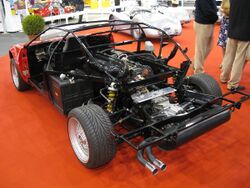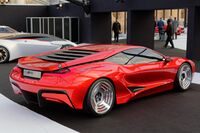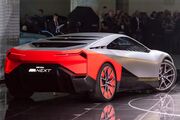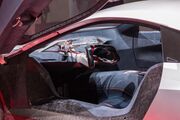Engineering:BMW M1
| BMW M1 | |
|---|---|
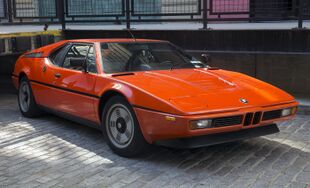 | |
| Overview | |
| Manufacturer | Karosserie Baur, BMW M GmbH |
| Production | 1978–1981 453 produced |
| Assembly | |
| Designer | Giorgetto Giugiaro at Italdesign |
| Body and chassis | |
| Class | Sports car (S) |
| Body style | 2-door coupé |
| Layout | Mid-engine, rear-wheel-drive |
| Powertrain | |
| Engine | 3.5 L M88 I6[1] |
| Transmission | 5-speed manual |
| Dimensions | |
| Wheelbase | 2,600 mm (102.4 in)[1] |
| Length | 4,361 mm (171.7 in)[1] |
| Width | 1,824 mm (71.8 in)[1] |
| Height | 1,140 mm (44.9 in)[1] |
| |uk|Kerb|Curb}} weight | 1,300 kg (2,866 lb) |
| Chronology | |
| Predecessor | BMW Turbo |
| Successor | BMW Nazca C2 (spiritual) |
The BMW M1 (model code E26) is a mid-engined sports car produced by German automotive manufacturer BMW from 1978 until 1981.
In the late 1970s, Italian automobile manufacturer Lamborghini entered into an agreement with BMW to build a production racing car in sufficient quantity for homologation, but conflicts arose that prompted BMW to produce the car themselves.[2][3] The resulting car was sold to the public, from 1978 until 1981, as the BMW M1.
It is the first mid-engine BMW automobile to be mass-produced; the second is the i8 plug-in hybrid sports car.
Overview
Development history
The motorsport division of BMW, headed by Jochen Neerpasch, had been wanting to compete in motorsports using a car developed for competition racing, in order to compete with arch rival Porsche in Group-5 racing. Thus, the development of the M1 was initiated. Neerpasch, who was head of the development program, stressed that the car was to be strictly mid-engine in order to outclass its competitors. As BMW wasn't able to build 400 road-going examples of the car in the required time period as stipulated by the rules, the company partnered with Lamborghini to work out the details of the car's chassis, assemble prototypes and manufacture the vehicles. The tubular steel space frame chassis was the work of Gianpaolo Dallara, but soon Lamborghini's financial position and the possibility of the car's production by the Italian manufacturer became bleak, and BMW reassumed control over the project in April 1978, after seven prototypes were built. The delay in production and the changes in Group 5 rules forced the company to compete in Group 4 racing with the car.[4]
The M1 coupé was hand-built between 1978 and 1981 under the motorsport division of BMW, as a homologation special for sports car racing. The fibreglass body was designed by Giorgetto Giugiaro, taking inspiration from the 1972 BMW Turbo concept car. Since the engineering of the car was still incomplete, a group of former Lamborghini engineers had founded a company named Italengineering, which offered to complete the car's design. Less than 10 miles away from the Lamborghini shop, the engineering for the M1 was finished.[5]
Engine and transmission
The BMW M1 is the first car to be solely developed by BMW M and employs a 3,453 cc (3.5 L) M88/1 petrol six-cylinder engine with Kugelfischer-Bosch mechanical fuel injection and Magneti-Marelli ignition system. The engine was developed by Paul Rosche, who was also responsible for the S14 inline-4 engine and the S70/2 V12 engine. A version of this engine was later used in the South African version of the 745i, of which 209 examples were built between 1984 and 1986, as well as the E24 M6/M635CSi and E28 M5. The engine has six separate throttle bodies, twin-cams, 4 valves per cylinder, and generates a power output of 277 PS (204 kW; 273 hp) at 6,500 rpm and 330 N⋅m (243 lbf⋅ft) of torque at 5,000 rpm in the road version, giving the car a top speed of 265 km/h (165 mph). The engine was mated to a 5-speed manual transmission made by ZF Friedrichshafen equipped with a 40% locking limited slip differential.
Steering, suspension and brakes
The M1 has an unassisted rack and pinion steering, double-wishbone suspension system with adjustable coil springs and Bilstein gas filled dampers. The road car had softer suspension bushings to have better ride quality and tractability.[4]
The ventilated brakes of the car measured 300 mm (11.8 in) at the front and 297 mm (11.7 in) at the rear and were constructed from steel. The M1 used special Campagnolo alloy wheels measuring 7x16-inches at the front and 8x16-inches at the rear fitted with Pirelli P7 tyres (having sizes of 205/55 VR15 at the front and 225/50 VR15s at the rear).
Interior
The M1 has a half-leather and half-cloth interior. Its motorsport roots meant that the car had a basic interior layout with many parts sourced from other BMW models. The interior had amenities such as air conditioning, power windows and a stereo but had unadjustable seats and only had a left-hand-drive configuration.
Production
The fibre glass body of the M1 was manufactured by Italian firm TIR (Trattamento Italiano Resina) which was located in Reggio Emilia, Italy. The chassis was manufactured by a Modenese firm, Marchesi. The body of the car was completed by Italdesign at their manufacturing facility located in Turin along with the interior.
The partly finished cars were then delivered to German specialist manufacturer Baur where final assembly took place by hand.[6] The hand-built M88/1 engines were supplied by BMW from Munich to be installed in the cars. The completed cars were shipped to BMW Motorsport in Munich for final inspection and delivery. Only 453 production cars were built, making it one of BMW's rarest models. Out of the 453, 399 were road going units while 53 were made for motorsport.[4][5]
Accolades
The M1 had various successes in motorsports. In 2004, Sports Car International placed the car at number ten on their list of top sports cars of the 1970s.
Motorsport
In 1979 the head of BMW Motorsport, Jochen Neerpasch, devised a one-make championship using racing modified M1s. The series was created to aid BMW in building enough cars to enter the group 4 classification in the World Championship for Makes. The new series, known as the "Procar BMW M1 Championship", served as a support series for Formula One, and included many Formula One drivers in identical cars.
The series ran for two years, with Niki Lauda winning the 1979 season, and Nelson Piquet the 1980 season. After BMW met the standards for group 4, the Procars were used by various teams in the world championship as well as other national series.
The M1 was also campaigned at the 24 Hours of Le Mans from 1981 to 1986 where it proved competitive.[4] The car was classified as a Group B car for Le Mans purposes, as Group B was also planned for GT class for road races, but were instead eclipsed by Group C prototypes.
A M1 Pro Car was also converted to Group B rally spec by BMW France for the 1982 season. The car was campaigned for the 1983 season as well before the car was entered solely by the Motul privateer racing team for the 1984 season. The 1984 season proved to be the most successful for the M1 as former ERC champion Bernard Béguin won back-to-back at Rallye de La Baule and Rallye de Lorraine that season, and even claimed an outright ERC podium at Rally d'Antibes four months later. The car was not campaigned further after 1984.[7]
Commemorative cars and spiritual successor
M1 Homage concept
In April 2008, BMW unveiled the M1 Homage concept, to commemorate the 30th anniversary of the M1. The concept vehicle uses a mid-engine layout that borrows styling cues from both the original M1 and the BMW Turbo show car.[8]
The M1 Homage concept was first shown to the public at the Concorso d'Eleganza Villa d'Este of 2008. The design was penned by BMW's in-house design team, inspired by both the original M1 and the BMW Turbo concept designed by Paul Bracq.[9] The BMW Turbo had many technical and advanced innovations from BMW that were part of the inspiration of the M1 Homage concept.[10] The front of the car differs the most from the other parts of the car. The front sports double head lights which are not the same as pop-up type that are on the original M1, but the usual trademark of the kidney grilles is present. The M1 Homage also incorporates the double badge on the back of the car like the original M1. There are no photos of the interior of the car or of the car in action, nor have the specifications of the car been released as the car was meant only to be a design exercise.
Vision EfficientDynamics concept and the BMW i8
After the M1, BMW designed some mid engined concept cars but none of them inspired a production car until 2013, when the Vision EfficientDynamics concept led to the production of the i8. The BMW i8 is based on the Vision EfficientDynamics concept, which is a range-extender electric car with a three-cylinder turbocharged petrol engine.[11] The production car was designed by Benoit Jacob.[12] Series production of customer vehicles began in April 2014.[13] It is also the first mass-produced mid-engine BMW automobile since the M1.[14]
Vision M Next concept
The Vision M Next is a plug-in hybrid concept sports car that was showcased in June 2019. The design is partially inspired from the M1, such as louvered rear windows and BMW roundels positioned inside the taillamps. It is powered by the Power PHEV drivetrain system that offers the choice between all-wheel-drive and rear-wheel-drive, with either all-electric propulsion or the power of a turbocharged four-cylinder petrol engine. The total system output is claimed at 441 kW (591 hp; 600 PS). It also has a claimed 0 to 100 km/h (62 mph) acceleration time of 3 seconds and top speed of 300 km/h (186 mph). The maximum range when driving in all-electric mode is claimed to be 100 km (62 mi).[15][16][17][18]
March-BMW M1/C prototype
| Category | IMSA GTX/GTP |
|---|---|
| Constructor | March Engineering BMW |
| Technical specifications | |
| Chassis | Aluminium monocoque, reinforced at key points with carbon fibre honeycomb, and a steel tube sub frame |
| Engine | BMW M88 3.5 L (210 cu in) DOHC I6 naturally-aspirated mid-engined BMW M12/9 2.0 L (120 cu in) DOHC I4 turbocharged mid-engined mid engine, longitudinally mounted |
| Transmission | Hewland DG300 5-Speed manual |
| Power | 650 hp (480 kW) @ 9000 rpm |
| Weight | 1,980 lb (900 kg) |
| Competition history | |
| Notable entrants | David Hobbs Racing |
| Debut | 1981 Los Angeles Times Grand Prix |
A highly modified version of the BMW M1,[20][21] the March-BMW M1/C, also known as the BMW-March M1/C, or simply the March 81P,[22] was an IMSA GTX/GTP sports prototype race car, designed, developed, and built by British constructor March Engineering, in collaboration with German manufacturer BMW, for sports car racing, in 1981.
References
- ↑ 1.0 1.1 1.2 1.3 1.4 Norbye, Jan P. (1984). "BMW Goes Racing: Motorsport, Engines, Adventures". BMW - Bavaria's Driving Machines. Skokie, IL USA: Publications International. pp. 186–189. ISBN 0-517-42464-9. https://archive.org/details/bmwbavariasdrivi00norb/page/186.
- ↑ New and Used Cars. "BMW M1 (1978-1981) CAR HISTORY". Is-it-a-lemon.com. http://www.is-it-a-lemon.com/used-car-history/bmw-m1.htm.
- ↑ "BMW (E26) M1". Qv500.com. http://www.qv500.com/bmwm1p1.php.
- ↑ 4.0 4.1 4.2 4.3 Harper, Bob (2018-01-28). "BMW M1: history, reviews and specs of an icon". Evo. https://www.evo.co.uk/BMW/M1.
- ↑ 5.0 5.1 Webster, Larry (June 2014). "BMW M1 Procar". Road & Track 65 (9): 66–69.
- ↑ "BMW M1". https://www.classicandsportscar.com/guides/classic-cars-a-to-z/bmw-m1.
- ↑ "Five cars you'd never expect to be turned into rally racers" (in en). 22 November 2018. https://driving.ca/jaguar/auto-news/news/five-cars-youd-never-expect-to-be-turned-into-rally-racers.
- ↑ Gluckman, David (April 2008). "2008 BMW M1 Homage Concept". Automobile Magazine. Source Interlink Media, LLC.. http://www.automobilemag.com/features/news/0804_bmw_m1_homage_concept/index.html.
- ↑ Kable, Greg (27 April 2008). "Homage to the master". Autoweek. Hearst Digital Media. https://www.autoweek.com/news/a2038466/homage-master/.
- ↑ "Concept Vehicles - M1 Homage Press Release - BMW North America" (Press release). BMW of North America, LLC. 27 April 2008. Archived from the original on 27 April 2011. Retrieved 2011-05-05.
- ↑ Abuelsamid, Sam (29 August 2009). "Frankfurt Preview: BMW reveals Vision EfficientDynamics turbodiesel plug-in hybrid concept [w/VIDEO"]. Autoblog.com. http://www.autoblog.com/2009/08/29/frankfurt-preview-bmw-vision-efficientdynamics-concept-turbodi/.
- ↑ Boeriu, Horatiu (24 December 2012). "BMWBLOG interviews Benoit Jacob, Head of Design BMW i". BMWBLOG. http://www.bmwblog.com/2012/12/24/bmwblog-interviews-benoit-jacob-head-of-design-bmw-i/.
- ↑ Eric Loveday (2014-03-10). "First BMW i8 Deliveries Scheduled For June – Final Performance / Fuel Consumption Figures Released". InsideEVs.com. http://insideevs.com/first-bmw-i8-deliveries-scheduled-june-final-perfomance-fuel-consumption-figure-releaseed/.
- ↑ "BMW i8 vs BMW M1". 28 November 2014. https://www.topspeed.com/cars/car-news/video-bmw-i8-vs-bmw-m1-ar166443.html.
- ↑ "BMW Vision M Next Concept revealed - a look forward, via the past | evo". https://www.evo.co.uk/bmw/22812/bmw-vision-m-next-concept-revealed-a-look-forward-via-the-past.
- ↑ "BMW M1 reborn as 591bhp two-seat plug-in hybrid | Autocar". https://www.autocar.co.uk/car-news/motor-shows-frankfurt-motor-show/bmw-m1-reborn-591bhp-two-seat-plug-hybrid.
- ↑ "BMW Vision M Next concept heralds plug-in performance at M division". https://www.motorauthority.com/news/1123616_bmw-vision-m-next-concept-heralds-plug-in-performance-at-m-division.
- ↑ Jun 26, Heidi R. Vanke on; Pm, 2019 at 1:35 (June 25, 2019). "BMW Vision M Next previews M1 supercar's successor - a dedicated 600 hp, carbon-bodied plug-in hybrid - paultan.org". https://paultan.org/2019/06/25/bmw-vision-m-next-previews-m1-supercars-successor-a-dedicated-600-hp-carbon-bodied-plug-in-hybrid/.
- ↑ "1981 March BMW M1/C: BMW USA Classic – BMW Car Club of America Foundation". https://bmwccafoundation.org/exhibits/heroes-of-bavaria/1981-marchbmw-m1c/.
- ↑ "BMW M1C : a new approach to GTP racing". https://alex62.typepad.com/imsablog/2007/01/bmw_m1c_a_new_a.html.
- ↑ "BMW-March M-1/C Archives - International Motor Racing Research Center". https://www.racingarchives.org/tag/bmw-march-m-1-c/#:~:text=The+BMW+M1/C+debuted,Photo:+Don+Hodgdon.
- ↑ "March 81P". https://www.racingsportscars.com/type/photo/March/81P.html.
 |
